Impetigo is easy to treat with antibiotics, which will usually clear it up within 7 to 10 days. It is not advised that you go without treatment. The infection can clear up on its own, but it is more likely to develop complications if it is not treated, & of course you are more likely to spread the infection to others. Be sure to wash your hands regularly & avoid touching the infected skin as much as possible in order to avoid spreading the bacteria.
Complications of impetigo include cellulitis, scarlet fever, guttate psoriasis, septicaemia, post-streptococcal glomerulonephritis, & Staphylococcal scalded skin syndrome (SSSS).
Definition
Impetigo is a highly contagious, common bacterial infection of the skin, caused by Staphylococcus aureus or Streptococcus pyogenes bacteria (staph infection). It is most frequently found in infants & children, & more so in warm, humid weather, but can affect anyone at any time. Impetigo will clear up with a course of treatment, although complications can develop if it is left untreated.
Symptoms
Impetigo symptoms primarily affect the outermost layer of the skin (the epidermis) with a crusty rash of blisters & sores which can be itchy & painful. It is most likely to appear on the face, around the nose & mouth, & on the hands, but it can also start around the waist & middle of the trunk, & it usually spreads to cover larger areas.
The main skin symptoms of impetigo are sores (non-bullous impetigo) or blisters (bullous impetigo). These are patches of skin, with a covering of thin skin (the roof), & filled with white or yellow pus.
These blisters then break easily, revealing round, red areas of skin beneath, which ooze & develop a yellow or brownish crust which may flake. At the outset of the infection, the blisters are small, just one or two centimetres across, but they slowly grow. Once they have healed, the blisters do not typically leave scars or discolouration.
The main features of the sores caused by the impetigo rash are:
- They start small but increase in size
- They begin in one area but spread to other body parts
- itching
- soreness, tenderness, or pain
- Golden, honey-coloured, crusted patches of skin that resemble cornflakes
- Highly contagious
The symptoms of impetigo are similar to other skin conditions, such as cold sores (which also begin as blisters around the mouth & lips), eczema (in which the skin is also cracked, itchy, & sore), & shingles or chicken pox (which also involves the formation of itchy blisters).
Your skin is more susceptible to impetigo if it is broken, so having an existing condition such as an open cut, scratch, or graze, an insect bite, scabies, cold sores, head lice, scabies, cold sores, or eczema can make you more likely to catch it (secondary impetigo). It can affect healthy skin as well, however (primary impetigo).






















